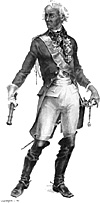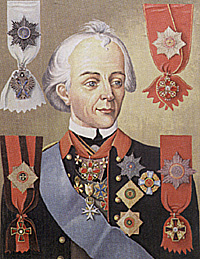 An Eccentric And Gifted Military Leader
An Eccentric And Gifted Military Leader
When the Imperial summons from Tsar Paul came in February 1799, the old general was in his sixty-ninth year. He had spent fifty-seven of those years campaigning against the Prussians, Poles, Turks and Tartars. He had sustained a multiplicity of wounds, three of them in the right leg alone. A great favorite of Catherine the Great, Suvorov was antagonistic to Tsar Paul's attempts to institute Prussian-style reforms, and no doubt the Tsar felt some reluctance in handing him the command.
Aleksandr Vasilevich Suvorov was born on 24 November 1730 to a middle-ranking family of Swedish origin which had settled in the province of Orel. His grandfather Ivan had been an associate of Peter the Great in the work of reforming the Russian army, and his father Vasily Ivanovich was the author of the first Russian translation (1724) of the works of French fortification master Vauban.
Real soldiering for Suvorov began in the Seven Years War. He was made lieutenant-colonel of the Kazan Infantry Regiment in 1758, served on General Fermor's staff in 1759, and on 25 July of that year received his baptism of fire in action against the Prussians at Crossen. In July 1761 Suvorov proceeded to command a flying column of Cossacks and hussars in a series of spectacularly successful operations against the Prussian hussars. At that period the leadership of light troops was reckoned to be the best possible training for higher command, for it fostered initiative, and developed an understanding of the relationships between forces, terrain, distance and speed.
Suvorov was made commander of a brigade of three battalions on 26 May 1769, and from then until the spring of 1772 he was engaged in campaigning against the Poles. It ended when he laid siege to the Castle of Cracow, which finally surrendered on terms (26 April 1772). He was rewarded with a crop of distinctions, including promotion to major-general.
Suvorov was beginning to make a name for himself through his improvised assaults of fortress walls, his dashing raids, and the ingenious ways he contrived to train the troops under his command. However, the true Suvorovian style was first displayed to the full in the course of his campaigns against the Turks in 1773 and 1774. As a newly-promoted lieutenant-general and the commander of a division of 8,000 troops Suvorov defeated an army of no less than 40,000 Turks at Kozludji on 21 June 1774. This victory did more than anything else to force the Turks to the conference table, and it brought Suvorov's name before the entire army.
Suvorov was promoted to full general in 1784, and in the third year (1789) of a new Turkish war we find Suvorov as commander of an elite Third or "Suvorov" Division, and designated to co-operate with the Austrian army of Field Marshal Josias of Saxe-Coburg. The subsequent battle of Rymnik (22 September) was a joint set-piece attack, which ended with the Turks driven from their position and routed, leaving 5,000 dead on the field. Catherine awarded Suvorov the cross and the black and gold ribbon of the St. George First Class, and bestowed on him the title of count.
It was unfortunate for Suvorov's wider reputation that his name was now linked with two of the bloodiest episodes of the century. Late in 1790 Catherine was eager to bring her Turkish war to an end, and a Russian army of 31,000 troops accordingly closed in on the major Turkish fortress of Izmail in the Danube delta. On 13 December Suvorov arrived to take immediate command of the operation. He did not have time to besiege Izmail in the same leisurely way he had attacked Cracow, and he took the place by open storm on 22 December. About one in every three of the Russians was a casualty, but the survivors revenged themselves in a frightful way, by killing some 26,000 Turkish soldiers and civilians.
In 1793 the second of the discreditable treaties of partition reduced Poland to a patch of territory standing under the "protection" of Russia and Prussia. A mass uprising broke out on 24 March 1794. Suvorov brought up a little army from the Ukraine by forced marches, beat a number of smaller Polish formations, and finally joined General Fersen in front of Warsaw.
Suvorov had only some 16,000 footsore troops under his command, but on 4 November he threw them into the storm of Praga, Warsaw's bridgehead on the right bank of the Vistula. The Russians finished off the defenders and townspeople alike in the same style as at Izmail, putting 13,000 Poles to the sword and bayonet, making 14,500 prisoners, and leaving 2,000 fugitives to drown when they tried to swim the river.
In his subsequent instructions Suvorov almost invariably emphasized the duty of sparing a beaten enemy, which would suggest an element of regret, and yet, when the massacre at Praga came up in conversation with his Austrian chief of staff in 1799, Suvorov described the deed as a calculated act, which spared blood over the long term by shocking the rest of the Poles into laying down their arms.
Suvorov was also celebrated as a man of unusual habits. Suvorov usually rose at four or earlier in the morning, and he refreshed himself by jumping into a trough of cold water, or having the liquid dashed over him by the bucketful. All serious affairs had to be conducted before the field marshal's notorious breakfast-cum-lunch, which began at nine in the morning and was prolonged for hours on end. The guests sat down to a meal of six, seven or eight courses, prepared to the highest Cossack standards, and served on badly-plated copper dishes in lieu of silver.
Suvorov led the conversation in his raucous voice, slipping from one language to the next, and varying his expression and emphasis according to the nature of the company. At one of the meals Lord Minto noted that before he sat down Suvorov had already consumed a tumblerful of powerful spirits which left even that old warrior gasping. As the lunch wore on "he drank a variety of strong things...; and as the bottle was going round, he held out his beer tumbler and had it filled again with champagne."
The company finally dispersed with splitting heads, and, according to one anonymous writer, "the field marshal at once lies down to sleep, an example followed by most of his suite. No matter how urgent the situation, which could be ignored only at the risk of extreme danger and damage, no more orders are sent, and everything is put off until the field marshal comes to himself, which is never before six in the evening."
The distinctive ways were not confined to mealtimes. "At the head of his army or on parade Suvorov could stand for half an hour at a time, shouting or singing. In a salon, in the midst of a most numerous company, he was likely to jump on a table or chair, or throw himself flat on the floor. On one occasion he gave vent to lamentations on the death of a pet turkey, which had been decapitated by a soldier. He kissed the defunct fowl, and tried to set the head back on the neck."
 The illustration of Field Marshal Suvorov at right was done by V.
Chernish on commission for John Sloan, who provided the details on the
Russian medals below. This portrait is a copy of the one by N. I. Utkin
in 1818. Unlike the original by Utkin, the artist has repeated the most
important decorations that Suvorov is wearing by putting them also in
the margins. These awards include:
The illustration of Field Marshal Suvorov at right was done by V.
Chernish on commission for John Sloan, who provided the details on the
Russian medals below. This portrait is a copy of the one by N. I. Utkin
in 1818. Unlike the original by Utkin, the artist has repeated the most
important decorations that Suvorov is wearing by putting them also in
the margins. These awards include:
Upper left, Order of St. Andrew the First Called (star and badge) instituted by Peter the Great in 1698 and the highest decoration for Russian officers; reserved for high ranks (not for valor) and given in one class.
Lower left on top of ribbon, Star of the Order of St. Vladimir (ribbon is red and black with also the star and badge for First Class); instituted for valor at arms in 1782 by Catherine II.
Lower right, Order of Alexander Nevski instituted in 1725 for feats of arms.
Upper right, Order of St. Anne shown in First Class instituted in 1797 by Tsar Paul.
Center bottom, among the many decorations below Suvorov's throat is the 8-pointed Star of the Order of St. John of Jerusalem (Knights of Malta) of which Tsar Paul was the Grand Master.
Barely visible under Suvorov's collar appears the black and orange ribbon of the Order of St. George with two white crosses. This is the highest decoration for valor in combat. A very rare award given to officers and generals for extraordinary military actions and exploits. The Gold Cross of St. George for officers was worn on a ribbon. This was given to officers who were at Ochakov in 1788 and again at Izmail in 1790, Praga in 1794, Bazardjhik in 1810 and Eylau in 1807. This is not the same as the Order of St. George. Officers and generals received this in gold and a silver St. George Cross in one class was worn on a orange and black ribbon for enlisted men.
The Allies Strike Back: Suvorov Retakes Italy 1799
-
Allies Strike Back: Introduction
Allies Strike Back: Movements
Allies Strike Back: Battle of Novi Begins
Allies Strike Back: Post-Battle
Allies Strike Back: Post-Novi Allied Grand Strategy Map (54K)
Allies Strike Back: Order of Battle: Text (fast: 15K)
Allies Strike Back: French Order of Battle: Graphics (slow: 235K)
Allies Strike Back: Russo-Austrian Order of Battle: Graphics (slow: 221K)
Allies Strike Back: Infantry Uniforms: Color (slow: 123K)
Allies Strike Back: French 11th Hussars Uniforms: Color (slow: 109K)
Allies Strike Back: Battle of Novi Maps (extremely slow: 532K)
Allies Strike Back: Joubert Biography
Allies Strike Back: Suvorov Biography
Allies Strike Back: Suvorov Painting (slow: 100K)
Back to Table of Contents -- Napoleon #15
Back to Napoleon List of Issues
Back to MagWeb Master Magazine List
© Copyright 2000 by Napoleon LLC.
This article appears in MagWeb (Magazine Web) on the Internet World Wide Web.
The full text and graphics from other military history magazines and gaming magazines are available at http://www.magweb.com
Order Napoleon magazine direct